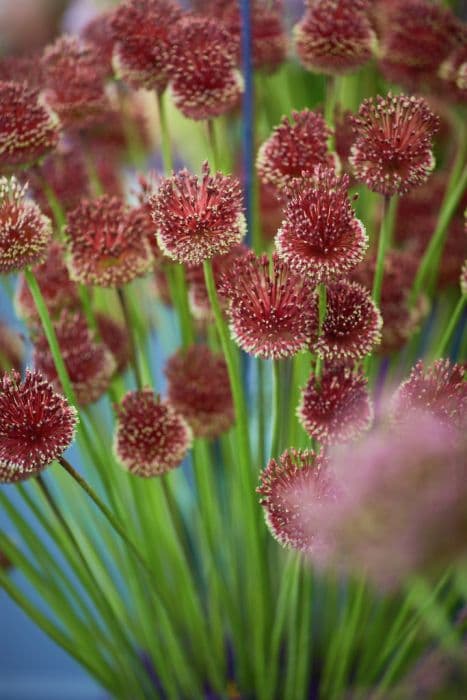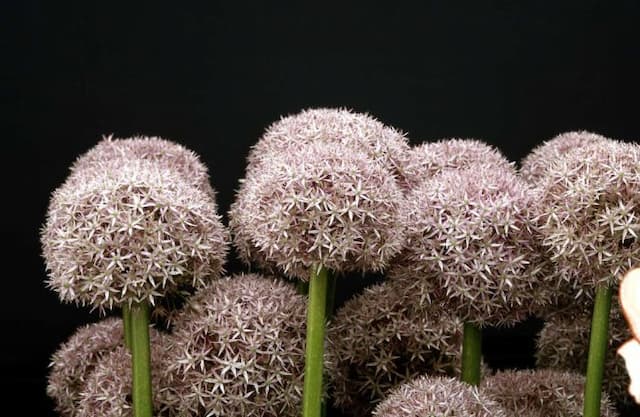Mouse garlic Allium angulosum

ABOUT
The plant known commonly as mouse garlic has a distinct appearance characterized by its grass-like leaves that are glossy and deep green in color. These leaves emerge from the base of the plant, providing a lush, verdant backdrop for its other features. During its blooming period, which typically occurs in the summer, mouse garlic produces clusters of star-shaped flowers. These flowers usually come in shades of pink and purple, lending a pop of color to its overall look. Each flower cluster is elegantly perched at the end of a sturdy, elongated stem, which rises above the foliage, allowing the blooms to stand out prominently. The flowers are small yet numerous, creating a soft, spherical shape that is quite eye-catching in the garden. As part of the genus that also contains onions, chives, and garlic, mouse garlic gives off a subtle aroma that's reminiscent of these culinary relatives, especially when the foliage is crushed or bruised. Adding to its attractive floral display, mouse garlic may also produce bulbils alongside the flowers or instead of them. These bulbils are small bulb-like structures that can eventually drop off and give rise to new plants, contributing to the spread of mouse garlic in its suitable growing environments. The overall form of the plant is clump-forming, which means that it grows in groups that can gradually increase in size, creating dense clusters of green and floral interest.
About this plant
 Names
NamesFamily
Amaryllidaceae
Synonyms
Mouse Garlic, Angle-Stemmed Chive
Common names
Allium angulosum L., Cepa angulosa (L.) Gray, Codonoprasum angulosum (L.) Rchb.
 Toxicity
ToxicityTo humans
Allium angulosum, commonly known as mouse garlic, is not considered toxic to humans. In fact, like other members of the Allium family, such as onions and garlic, it is edible and used in cooking for its flavor. However, individuals with a sensitivity or allergy to Allium species may experience adverse reactions, which could include stomach discomfort, indigestion, or allergic reactions. Otherwise, there are no toxic effects expected from ingesting mouse garlic in normal food quantities.
To pets
Mouse garlic can be toxic to pets, especially cats and dogs, as they might be sensitive to certain compounds found in Allium species. If pets ingest mouse garlic, symptoms of toxicity can include vomiting, diarrhea, abdominal pain, loss of appetite, and in more severe cases, damage to red blood cells, leading to anemia. If you suspect your pet has ingested mouse garlic, it is important to seek veterinary attention promptly. In the absence of proper treatment, the consequences of Allium poisoning in pets can be serious and potentially life-threatening.
 Characteristics
CharacteristicsLife cycle
Perennials
Foliage type
Deciduous
Color of leaves
Green
Flower color
Pink
Height
1-2 feet (30-60 cm)
Spread
0.5-1 feet (15-30 cm)
Plant type
Bulb
Hardiness zones
4
Native area
Europe
Benefits
 General Benefits
General Benefits- Culinary Uses: Allium angulosum, known as mouse garlic, can be used in cuisine for its flavorful bulbs and leaves, adding a subtle garlic flavor to dishes.
- Ornamental Value: Mouse garlic produces attractive star-shaped flowers which can enhance the visual appeal of gardens and landscapes.
- Wildlife Support: It can be beneficial for pollinators such as bees and butterflies, providing a source of nectar.
- Erosion Control: With its robust root system, mouse garlic can help stabilize soil and prevent erosion in certain environments.
- Low Maintenance: Mouse garlic typically requires minimal care, making it suitable for gardeners looking for low-maintenance plants.
- Edible Landscaping: As an edible perennial, mouse garlic can be incorporated into edible landscaping, serving both aesthetic and functional roles.
- Cultural Significance: In some cultures, mouse garlic has been used traditionally in various culinary and ceremonial applications, enriching cultural practices.
 Medical Properties
Medical Properties- Antibacterial: Allium angulosum has been reported to possess antibacterial properties, potentially effective against certain bacteria.
- Antifungal: The plant may also have antifungal effects, useful in inhibiting the growth of certain fungi.
- Antioxidant: It contains compounds that exhibit antioxidant activities, which can help in protecting cells from oxidative damage.
 Air-purifying Qualities
Air-purifying QualitiesThis plant is not specifically known for air purifying qualities.
 Other Uses
Other Uses- Allium angulosum, commonly known as mouse garlic, can be utilized as a natural dye for textiles, imparting a range of colors depending on the mordant used.
- In landscape gardening, mouse garlic is appreciated for its hardiness and ability to thrive in a variety of soils, contributing to diverse garden designs.
- Mouse garlic can serve as a companion plant in vegetable gardens, reportedly deterring certain pests and potentially beneficial for the growth of plants like tomatoes.
- The blossoms of mouse garlic are sometimes used in floral arrangements, both fresh and dried, due to their unique globe-like shape and visual interest.
- Leaves of mouse garlic can be used as a fodder for some livestock, particularly sheep, when other resources are not abundantly available.
- Its robust nature allows mouse garlic to be used for erosion control in areas susceptible to soil degradation.
- The seeds of mouse garlic can be collected and used to grow microgreens for culinary experimentation.
- Species like mouse garlic can play a role in phytoremediation, a process utilizing plants to absorb and sequester harmful toxins from the soil.
- In rural traditions, it can be used as a marker plant to indicate the changing of seasons or as an organic calendar for farming activities.
- The plant's structure and growth pattern make it suitable for use as a ground cover in gardens, aiding in the suppression of weeds.
Interesting Facts
 Feng Shui
Feng ShuiMouse Garlic is not used in Feng Shui practice.
 Zodiac Sign Compitability
Zodiac Sign CompitabilityMouse Garlic is not used in astrology practice.
 Plant Symbolism
Plant Symbolism- Strength and Stability: As a member of the Allium family, Allium angulosum (known commonly as Mouse Garlic) shares the family's symbolic representation of strength and stability, due to their robust nature and firm standing stems.
- Unity: The spherical shape of the Mouse Garlic's blooms can represent unity, with the cluster of individual flowers symbolizing togetherness and the whole being greater than the sum of its parts.
- Protection: Historically, alliums have been thought to offer protection against evil spirits and diseases, which translates to Mouse Garlic being seen as a symbol of guarding and shielding.
- Perseverance: Mouse Garlic is a hardy plant capable of thriving in difficult conditions, so it symbolizes perseverance and the ability to overcome challenges.
- Healing: Because many Allium species have been used for medicinal purposes, Mouse Garlic may also be associated with healing and the restoration of health.
 Water
WaterMouse garlic, or Allium angulosum, prefers to be watered deeply but infrequently, ensuring that the soil has a chance to dry out somewhat between waterings. A good rule of thumb is to provide about one to two inches of water every week, which approximately translates to about 0.5 to 1 gallons for an average-sized plant, depending on weather conditions and soil type. Overwatering can cause bulb rot, so it is crucial to ensure good drainage. During the growing season, increase watering slightly, but always check the top inch of soil for dryness before watering again. In winter, reduce watering as the plant goes dormant.
 Light
LightMouse garlic thrives best in full sun exposure, meaning it should receive at least six hours of direct sunlight per day. The ideal spot for this plant would be in a south or west-facing garden where it can benefit from the maximum amount of sunlight. However, it can also tolerate partial shade, especially in hotter climates where the afternoons are very intense.
 Temperature
TemperatureMouse garlic grows well in a wide range of temperatures but performs best when the temperature stays between 55°F and 75°F. It can survive minimum temperatures down to around 28°F but should be protected from prolonged freezing conditions. During the summer months, it can handle temperatures up to about 90°F without issue.
 Pruning
PruningPruning mouse garlic is primarily done to remove spent flower stems to encourage new growth and maintain a tidy appearance. Prune these stems back to the base of the plant after the flowers have faded and seed pods have formed, typically in late summer or early autumn. Regular deadheading during the flowering season can also promote additional blooms. It is not necessary to prune this plant heavily; simply keep it tidy.
 Cleaning
CleaningAs needed
 Soil
SoilMouse garlic prefers well-draining soil enriched with organic matter. The best mix would consist of garden soil, compost, and a small amount of sand to ensure drainage. Ideal soil pH for mouse garlic should be between 6.2 and 7.0, slightly acidic to neutral.
 Repotting
RepottingMouse garlic, or mouse garlic, typically doesn't require frequent repotting. Repot once every 2-3 years, or when it's evident that the plant has outgrown its current container.
 Humidity & Misting
Humidity & MistingMouse garlic thrives best in outdoor conditions where it can receive natural humidity levels. It is not particularly demanding regarding humidity; average outdoor conditions are sufficient.
 Suitable locations
Suitable locationsIndoor
Ensure bright light and good air circulation for mouse garlic.
Outdoor
Plant mouse garlic in full sun to partial shade, ensuring well-drained soil.
Hardiness zone
4-8 USDA
 Life cycle
Life cycleAllium angulosum, commonly known as mouse garlic, begins its life cycle as a seed, which germinates in moist soil conditions to produce a small seedling. The seedling grows into a bulb, which is a key storage organ of the plant, enabling it to survive through unfavorable conditions. As it matures, the bulb produces leafy shoots that emerge above ground in the spring. The plant develops a characteristic flowering stalk that bears an umbel of star-shaped flowers, usually in the summer, which are pollinated by insects to facilitate sexual reproduction. After pollination, seed capsules form and, upon ripening, release seeds to start a new generation. The plant goes dormant in the winter, with the bulb surviving underground ready to regenerate the next spring.
 Propogation
PropogationPropogation time
Spring to early summer
The most popular method of propagation for Allium angulosum, commonly known as mouse garlic, is by dividing its bulbs. The best time to do this is in autumn when the plant is dormant. Gardeners should carefully dig around the plant, lift the clump of bulbs, and gently separate them into individual bulbs. Each bulb can then be replanted immediately at a depth of 2 to 3 inches (5 to 7.5 centimeters) with the pointed end facing upwards, spaced about 8 inches (about 20 centimeters) apart to allow for ample growing room. Adequate watering after replanting is essential to help establish the new plants.









